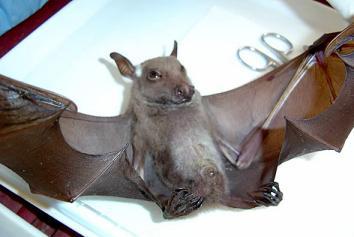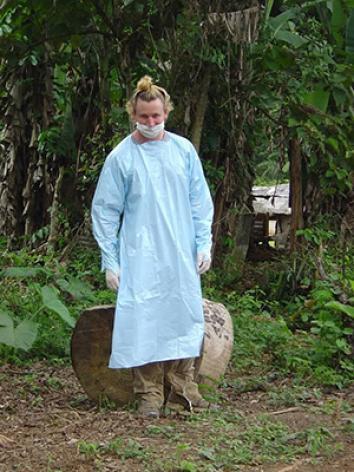The first time I put a blowgun in my mouth, my focus wasn’t on hitting the target; it was on not swallowing the tranquilizer dart. I zeroed in, closed my eyes, and forcefully expelled a gust of air. So forcefully, in fact, that I sent the tiny missile 20 feet over the wooden bulls-eye. My instructor shook his head and moved his hands from his hips to my neck. “Aim low,” he said, inching my face downward, “if you’re gonna blow so hard.” It was the spring of 2004 and we were standing in an open field in Worcester, Massachusetts, where I was preparing to hunt the Ebola virus.
I was a medical student at Harvard at the time, and I’d responded to a flier seeking an animal catcher willing to spend the summer in Africa. I had no such training, but I was interested in living abroad, so I contacted the group—the Consortium for Conservation Medicine—and told them I wanted in. A few weeks later, I began learning how to subdue wild animals that were thought to transmit lethal viruses. A few months after that, I traveled to Cameroon to attempt to answer a surprisingly difficult question: Where does Ebola go between human outbreaks?
The man hoping to answer this was Nathan Wolfe, a renowned virus hunter whom The New Yorker once referred to as “a swarthy man with a studiously disheveled look,” who “comes off as a cross between a pirate and a graduate student.” When I arrived in Yaoundé, the capital of Cameroon, I was driven by an armed guard to a two-story house in a wealthy part of town where Wolfe was planning his next move. The house was surrounded by barbed wire and guarded by a man in camouflage holding a rifle. I would not need my blowgun.
Inside the house, I met my team: six animal handlers from around the world who were preparing to spend several weeks in the jungle. One of Wolfe’s colleagues explained the plan. The team in Cameroon—as well as scientists from rival groups in other countries—had a hunch that Ebola was living harmlessly inside of fruit bats. These creatures were known to harbor all kinds of deadly viruses, from rabies to Marburg, but no one had definitively shown that Ebola lived in bats. They wondered if fruit bats were somehow giving Ebola to humans.
A day later, we took our headlamps and backpacks and headed deep into the West African jungle, hoping to be the first to establish the link. Over the next few nights, we tracked the feeding patterns of fruit bats on the outskirts of a small village. Every night around dusk, hundreds of bats would fly in a V-formation over a large hill, searching for their next meal. (Fruit bats eat—you guessed it—fruit.) Once we understood their flight plan, we pulled out our nets, which were about 12-feet wide and resembled volleyball nets. But ours were made with a special mesh that couldn’t be detected by the bats’ sonar.
Shortly before dusk, we scurried up the hill and tethered the nets in trees. Then we waited. As the sun went down, hundreds of bats flew over the hill in search of an evening feed, and dozens went careening into our nets. My job was to remove the potentially Ebola-infested fruit bats from the net. And I was terrified. What if one of these things bit me?
After untangling the bats from the netting—I wore thick gardening gloves throughout the nerve-wracking ordeal—I placed the screeching creatures in a sack and brought them to a small hut. Then I put on a surgical gown, face mask, latex gloves, and safety goggles and went to work. On a wooden table inside the hut, I took a large needle and plunged it into the bat’s heart to extract blood. (The bats did not survive the procedure.) The blood was then sent back to a laboratory in the United States, where it was tested for a number of viruses, including Ebola.
Once we were done collecting bat blood, we went into the neighboring village and met with the chief and a group of hunters to explain the concerns that had brought us there. The men sipped whiskey as we discussed the risks of eating bat, chimpanzee, and gorilla meat. One hunter brushed his teeth with one hand while holding a fresh primate carcass with the other as we spoke. The villagers were willing to listen, but most had spent their entire lives consuming this type of food without a problem. Why stop?
Well, it turns out Ebola virus does live in fruit bats, although other researchers beat us to this conclusion. What’s more, these mammals—also known as flying foxes—appear to be the primary reservoir from which humans acquire the infection. Scientists still haven’t worked out the details, but one theory is that bats transmit Ebola to chimpanzees and gorillas (and possibly other animals like dogs and pigs) through their droppings, and humans contract the virus by coming into contact with those infected animals. This is likely what happened in the Ebola outbreak of 1996 in Gabon, when an infected chimpanzee found in the forest was butchered and eaten by 19 people. People may also contract the disease directly from bats; researchers believe the current Ebola outbreak was caused by a toddler’s chance encounter with a single infected fruit bat. (It’s not known whether the toddler was bitten by a bat or ate an infected one.)

Photo courtesy of Matt McCarthy
So why bats? How come they can live with Ebola and so many other viruses, while humans can’t? Scientists bitterly disagree about this. One theory is that fruit bat chromosomes harbor more genes to repair damaged DNA than other species, which allows them to coexist with viruses that typically attack a host’s nucleic acids. Put simply, bats have more resilient DNA. Another theory, outlined in a terrific piece in Wired, is that bats have overactive immune systems. The idea is that the nightly trek to find food generates enough metabolic activity to mimic a fever, and that revs up the bat’s immune system enough to keep Ebola at bay. Other researchers suggest it’s just a numbers game: Bats make up nearly one-quarter of the mammalian species on Earth, and what we’re seeing is just the statistical inevitability that some bat species will be unharmed by these viruses. If we’re going to contract any disease from another species, there’s a decent chance it’ll be from a bat.
So other than slaughtering all of the fruit bats and primates in Africa—while simultaneously convincing rural Africans to stop eating them—what do we do about it? We have no cure for Ebola, and even the experimental treatment ZMapp has been used up. Are we simply left to play defense while the virus kills thousands of people in West Africa and spreads around the globe?
On Sept. 29, the World Health Organization convened an urgent meeting on how to produce an Ebola vaccine. The group discussed two vaccine candidates: cAd3 from GlaxoSmithKline and the U.S. National Institute of Allergy and Infectious Diseases, and rVSV from NewLink Genetics and the Public Health Agency of Canada.
Phase 1 studies (which determine the safety of a vaccine but not necessarily efficacy) of cAd3 have begun in the United States and the United Kingdom, and researchers plan to begin enrollment for trials of rVSV later this year. Both vaccine candidates have demonstrated 100 percent efficacy in studies in nonhuman primates, so there’s reason to be optimistic. But even if adequate safety and immunogenicity are demonstrated in humans, these vaccines will not be available until the first quarter of 2015.
Without a vaccine or an effective medication, we’re left with experimental blood transfusions from survivors and supportive care (oxygen, fluids, electrolyte repletion) in conjunction with infection prevention, surveillance, and control measures—which thus far have proven insufficient. If the situation continues to spiral out of control, we may see large-scale quarantines.
As of Oct. 14, the cumulative number of probable, suspected, and laboratory-confirmed cases attributed to Ebola virus is 9,216, including 4,555 deaths. The number of cases is predicted to exceed 20,000 by early November, which many believe is a conservative estimate. This Ebola outbreak—the 25th known outbreak since 1976—has already killed more than all of the previous outbreaks combined.
At some point, this outbreak will ebb and Ebola will fade from the headlines and our collective consciousness. But it won’t disappear. It will live on in the jungle—swimming in the blood of fruit bats and possibly other species—until it makes the leap back into humans for the next outbreak. Next time, let’s hope we’re more prepared.
